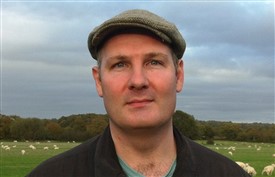Ashford's Worst Day: the 'Great Raid' of 24 March 1943

Ed Adams, author
Our thanks to Ed for giving his most enlightening talk on 30 November.
Local historian, author and publisher Ed Adams will be giving a talk starting at 7pm in the Village Hall on 30th November. Free entry, everyone is welcome.
On 24 March 1943 Ashford experienced the worst single air-raid, in terms of death and injury, to occur in Kent during the Second World War. Fifty two people died as a direct result of that day's events, with three times as many injured. Ashford was a key objective for the Luftwaffe because of the Newtown railway works at Newtown, which that morning was targeted by twelve Focke-Wulf 190 fighter bombers using the new tactic of 'tip and run'. They had taken off from St. Omer in enemy-occupied France, each with a 500kg bomb. They flew just above the sea at speeds of up to 350mph and then across Romney Marsh at tree-top level to avoid detection.
At 9.58 and 30 seconds Ashford’s Civil Defence Control received an alert from the Observer Corps on the coast that hostile aircraft were heading in their direction, and the civilian air-raid siren was immediately sounded. By now the aircraft had gained altitude to clear Collier’s Hill at Mersham but once over immediately dropped low again, below the level of the hill’s summit. Not therefore outlined against the blue sky, and with the morning sun directly behind them, to observers looking south-east from Ashford they were all but invisible.
Some bombers hit the objective; others, harassed by anti-aircraft fire, overshot the railway works and dropped their bombs indiscriminately over the town, firing cannon shells and machine-gun bullets as they went. Four of our Bofors guns nearest to the railway works claimed five hits between them despite one of the guns jamming twice.
London was defended by concentric rings of anti-aircraft guns, several of which were stationed near Hothfield including at Tutt Hill. No doubt on 24 March 1943 these were pressed into action. Hothfield was not bombed that day but six of the bombers carried on after bombing the railway works to attack the Royal Electrical and Mechanical Engineers stationed at Repton Manor.
Their base has since been redeveloped and is now the back garden of no.2 Barley Mow View and behind Repton Manor Primary School. Ed’s talk will compare views of the locations as they were then and now. Stores and bunk-rooms were hit, as well as the Nissen huts used as dining halls for the soldiers (male) and ATS (female). A mobile dentists’ van parked by the men’s dining hall received two cannon shells, and around ten oil drums, camouflaged by netting, were also ripped open by shells. The contents flowed out but luckily did not ignite. An ATS orderly on duty in the men’s dining hall was struck in the thigh and knee by fragments of a cannon shell that exploded on the concrete floor. Outside, three civilian contractors could only find a hedge under which to take cover from the attack. They were hit by machine-gun bullets: one in the chest and leg; one in the back, left arm and left thumb; the third in the left calf. All four casualties were taken to Hothfield Hospital for treatment and recovered from their injuries. Vickers guns had just been installed there three weeks before and hit one of the attacking aircraft.
Ed Adams, author of the recently published 'Ashford at War', will present a comprehensive account of those three minutes of horror, together with an analysis of the causes and consequences, and many rare and unseen photographs which include comparisons of scenes as they were then and are now.
Ed is a freelance author and historian, and the owner of Tenterden-based Canterley Publishing Ltd, a company specialising in local-interest and heritage books. He has written extensively on aspects of Kent’s history, including the Home Front of the Second World War, individual histories of various schools, and past-and-present photographic commentaries. Copies of ‘Ashford at War’ will be available to buy.
Refreshments will be available at the talk for which donations will be welcome.